Summary
A strong unemployment insurance (UI) system supports workers, communities, and the economy by enabling workers who have lost their jobs to maintain basic economic security as they search for new employment. Yet the UI system falls far short of its potential. To better understand the strengths and weaknesses of UI, we surveyed 1,480 workers who experienced unemployment at some point from 2019 to 2024, asking about their experiences navigating unemployment and applying for and receiving benefits. Analysis of the Unemployed Worker Study suggests that UI benefits significantly reduce economic hardship for workers who receive them. Yet workers face numerous challenges related to eligibility for UI, barriers to accessing benefits, and the inadequate level and duration of benefits. We examine variation across states and offer recommendations for state and federal governments and employers to improve UI.
Key Findings
- Unemployment insurance (UI) benefits reduce hardship: Workers who received benefits were significantly less likely to report food and housing insecurity.
- Although the pandemic unemployment surge is over, unemployed workers still face barriers to accessing benefits, including delayed decisions, difficulty with UI websites, and trouble reaching UI agencies by phone.
- One in five UI applicants say benefit levels are inadequate. Workers are more likely to say benefits fall short in states that offer lower UI benefits and fewer weeks, particularly in southern states.
- Employers play a major role in UI access: 29% of UI applicants report an employer helped or hindered them in applying for UI.
Recommendations
- States should improve UI access, broaden eligibility, and ensure benefit levels and duration meet workers’ needs.
- The federal government should set strong UI standards all states must meet.
- Employers should support workers in accessing benefits they are entitled to.
Why This Matters
As analysts increasingly warn of the risk of imminent recession, strengthening unemployment insurance should be an urgent priority for policymakers.
Introduction
Unemployment insurance (UI) is a critical piece of the nation’s social and economic infrastructure. At its best, UI enables workers, communities, and the economy to thrive by providing an ample and accessible source of income for workers who lose their jobs. A well-functioning UI system not only protects workers and their families from economic hardship; it also strengthens the economy during economic downturns by bolstering consumer demand,[1] and ensures jobseekers are not forced into substandard jobs that could depress wages and degrade working conditions. In addition, economists find that a robust UI system enhances job matches, improving the overall functioning of the labor market and helping employers connect with workers who have the right skills for the job.[2] By giving workers enough time to find suitable jobs, UI can also contribute to higher wages and greater job satisfaction when jobseekers secure new work.[3] Finally, UI benefits contribute to worker voice, making workers more comfortable speaking up about workplace abuses such as sexual harassment and unsafe working conditions when they know that they can receive UI benefits if their employer retaliates against them.[4]
During the last economic downturn, UI benefits provided support to 1 in 6 U.S. adults and kept at least 4.7 million people out of poverty, serving as one of the nation’s most effective economic stimulus measures.[5] Despite these powerful benefits, the UI system still falls far short of its full potential.
UI is a federal-state partnership, with states making key decisions about benefit levels, duration, eligibility, and access. For decades, UI experts and non-partisan government watchdog bodies have warned that the state agencies that administer UI struggle to fund UI benefits and administrative costs.[6] At the same time, advocates for unemployed workers point out that many states provide insufficient benefits, have established eligibility rules that exclude many unemployed workers, and make it difficult for workers to access the support they need.[7] Racial inequity is also a persistent concern: Workers of color are disproportionately shut out of the system, despite consistently experiencing higher unemployment rates due to structural racism in the labor market.[8] Researchers also find that Black workers who receive UI benefits typically have less of their income replaced by UI benefits than their white counterparts.[9]
The last five years have been especially tumultuous for unemployed workers and the UI system. In 2020, when the COVID-19 pandemic triggered the largest job losses in the U.S. since the Great Depression, Congress dramatically expanded UI benefit amounts, duration, and eligibility on a temporary emergency basis. This expansion kept millions of families out of poverty[10] and was among the most effective measures at stabilizing the economy.[11] Yet the unprecedented number of unemployed workers trying to access benefits put a massive strain on state UI systems, exacerbating longstanding weaknesses. When federally-funded pandemic benefits expired in September 2021—and were curtailed several months earlier in some states—workers again faced lower benefit levels, stricter eligibility rules, and lower limits on how long they could receive benefits.
At the same time Congress was providing ramped up unemployment assistance to workers, it was also working to shore up UI administration. The 2021 American Rescue Plan Act provided $2 billion (later reduced to $1 billion) to the U.S. Department of Labor in an effort to improve the UI system. Most of this money was disbursed in grants to state agencies to upgrade UI systems with the aim of promoting equitable access to UI, ensuring the timely payment of benefits, and improving the system’s integrity.[12]
How did these dramatic changes play out in the lives of unemployed workers? To better understand workers’ experiences with unemployment and UI during and after the pandemic, we surveyed a nationally representative sample of 1,480 workers who had experienced unemployment between 2019 and 2024. The survey was conducted online by YouGov in September 2024. The Unemployed Worker Study asked about workers’ experiences of hardship during unemployment, barriers to and assistance with accessing UI benefits, and whether benefit amounts and duration were sufficient to support workers seeking new jobs. The survey also inquired about employers’ role in helping or hindering workers’ access to benefits. See the appendix for additional information about the survey methodology.
Unemployment Benefits Reduce Hardship
Unemployment benefits are a critical resource for families struggling to pay for basic needs while an income earner looks for a new job. The Unemployed Worker Study finds that workers who received unemployment benefits reported less material hardship—including food insecurity, trouble paying medical expenses, and falling behind on mortgage or rent payments—than unemployed workers who applied for but did not receive UI support.
For example, as Figure 1 shows, 33 percent of UI recipients reported experiencing food insecurity compared to 51 percent of UI applicants who did not receive benefits. This significant reduction in food insecurity[13] demonstrates UI’s positive impact. Still, the 1 in 3 UI recipients who reported food insecurity despite receiving benefits also underscore the need for states to raise benefit levels (see the section below on how UI benefit amounts often fall short of meeting workers’ needs).
33 percent of UI recipients reported experiencing food insecurity compared to 51 percent of UI applicants who did not receive benefits.
Workers receiving UI benefits also reported less difficulty paying medical bills (a 7 percentage point difference)[14] than UI applicants who did not receive benefits, and workers who received UI were less likely to report housing insecurity than UI applicants who did not receive benefits (although this difference was not statistically significant at conventional levels of significance).[15] These striking differences remain after controlling for education, race, gender, age, state of residence and other factors.[16]
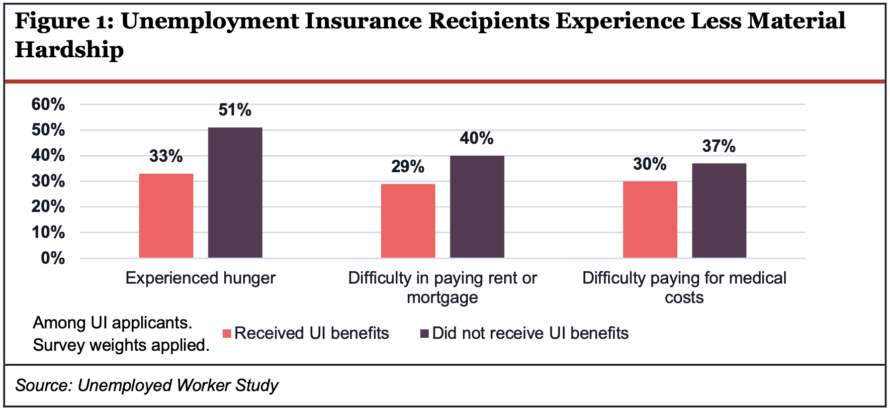
These findings are consistent with other research showing that UI benefits significantly reduced hardship during the pandemic recession.[17] In addition, the Unemployed Worker Study looks at the post-pandemic period (2022-2024), finding that UI benefits continued to alleviate food, medical, and housing insecurity among workers and their families, highlighting how critical UI remains to unemployed workers even when the economy is growing. Reports of UI’s impact on economic hardship were largely consistent across education and race, illustrating the importance of UI benefits for all workers.
Workers Face Major Barriers to Accessing UI – Even After the Pandemic
As critical as UI benefits are for reducing hardship, applying for them can be a confusing and difficult process. The chaos of UI applications during the pandemic has been widely reported: Laid-off workers struggled with crashing websites, jammed phone lines, and prolonged waiting periods to access the benefits they were due.[18] Behind the scenes, overburdened, understaffed state agencies attempted to process the unprecedented surge of UI applications while navigating the rules of new and unfamiliar federal UI programs, often using antiquated technology.[19]
Our survey findings reflect this turmoil: During the pandemic (2020-2021), many unemployed workers reported dealing with hard-to-navigate UI agency websites (23%) and difficulty reaching the UI agency by phone (21%). If they succeeded in submitting claims for unemployment benefits, workers confronted delays in receiving checks (22%) and in decisions about their eligibility (20%). Overall, 32 percent of applicants during this period reported at least one problem with contacting UI agencies and 31 percent of applicants reported at least one issue with delayed payments.
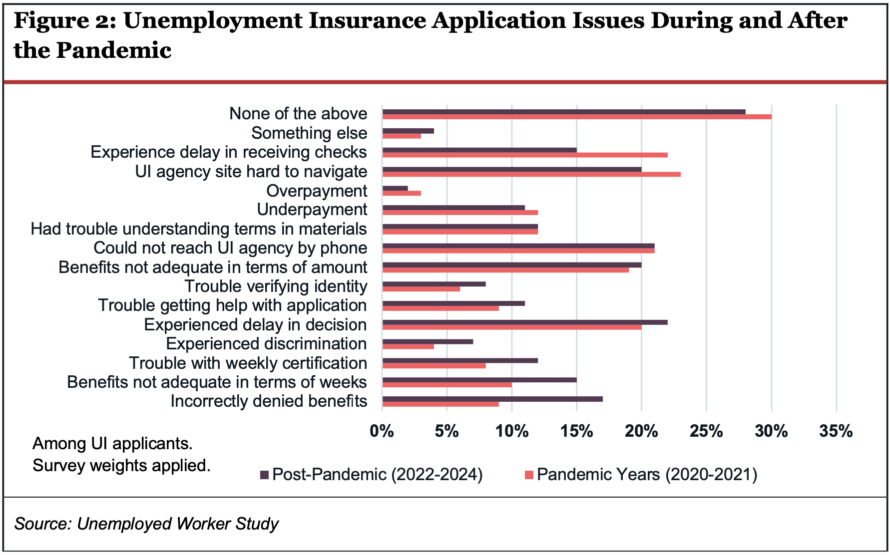
In the post-pandemic years (2022-2024), as states worked through their backlog of UI claims, some of these barriers to access were reduced, yet others persisted and grew. For example, although fewer workers reported delays in receiving UI payments (from 21 percent during the pandemic to 17 percent in the aftermath), delays remained common. Late unemployment insurance payments can contribute to financial hardship for families already struggling due to job loss, leaving them to fall behind on bills and even face foreclosure or eviction.[20] Our findings on delayed benefits are consistent with research finding that state agencies are improving timeliness post-pandemic but still having difficulty meeting federal standards for timely payments.[21]
Unemployed workers also continued to report having trouble navigating UI agency websites and reaching agencies by phone in the post-pandemic period. This persistent barrier to accessing UI benefits illustrates the importance of federal technical support and funding for states’ UI modernization efforts. In addition to the one-time infusion of funds from the American Rescue Plan Act, states need a reliable, sufficient source of federal administrative funding to continue user-friendly website upgrades, adequately staff phone lines, and take other needed steps to consistently improve workers’ access to the UI benefits they are due.
The Unemployed Worker Study also reveals workers’ growing sense of the unfairness of the UI system. During the pandemic, 9 percent of workers who applied for UI reported that they were incorrectly denied benefits. In the post pandemic years, this percentage doubled to 18 percent. Federal benefit accuracy measurement data does not indicate a comparable increase in improper denials during this period.[22] However, the overall rate of denied UI claims (including claims that were both properly and improperly denied) did increase substantially following the termination of federal pandemic UI programs in 2021.[23] When federal pandemic programs ended, so did their expanded eligibility criteria: Workers then had to meet the much narrower requirements of regular state UI programs to qualify for benefits.[24] The fact that workers’ claims for UI benefits were being assessed under different, more stringent criteria than they would have been just a short time earlier may have contributed to the growing sense that UI claims were unfairly denied. Advocates also point out that narrow state eligibility criteria are not always clearly explained to UI applicants, which may further contribute to a sense of unfairness when claims are denied.[25]
Workers Seek Help Dealing with Unemployment
The experience of being unemployed can be overwhelming and disorienting. Many workers seek additional information or assistance in dealing with unemployment, which could include help applying for benefits, searching for another job, and/or seeking financial support from loved ones. The Unemployed Worker Study finds that the most common sources of information or help about how to deal with unemployment included friends or family (35%), consulting an online forum or site (18%), or connecting with a government agency (16%). About 12 percent of workers received help from a church or faith group or a non-religious community group, and 9 percent of workers were assisted by their employer. Forty-three percent of workers reported that they did not use any source of information or help to deal with their unemployment.
Workers with less formal education were much less likely to report receiving outside support in navigating unemployment than workers with higher levels of education. For example, 48 percent of workers with a high school diploma or less report they didn’t use any source of information or assistance to deal with being unemployed, compared to 33 percent of workers with a bachelor’s degree and 35 percent of workers with a post-graduate degree. Workers with more formal education were significantly more likely to receive help and information online, from a government agency, or from their employer than their counterparts with less formal education.
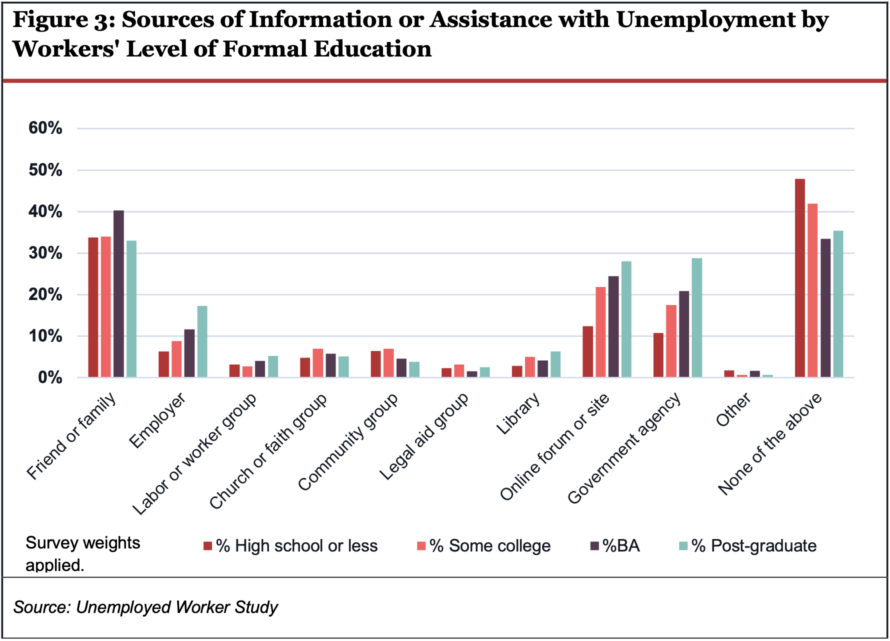
The finding that workers with less formal education are less likely to obtain unemployment help from any source suggests that it is especially important for state UI agencies to affirmatively assist these workers—–especially since workers with less formal education are less likely to apply for and receive UI benefits, even if they might otherwise be eligible for those benefits.[26] One promising avenue to support and connect with underserved workers—including those with less formal education—involves partnering with worker, labor, and community-based organizations as trusted intermediaries helping recently laid-off workers understand and navigate their options. The U.S. Department of Labor funded state pilots for such navigation assistance, and researchers have found that the Peer Workforce Navigator program piloted in Maine succeeded in increasing access to unemployment benefits and new jobs.[27]
Identity Verification is an Increasing Barrier to Benefit Access
Confronting a wave of fraudulent UI claims from criminal organizations using stolen identities, states hastily introduced new ID verification technology during the pandemic.[28] Yet technology intended to deter fraud has also become an obstacle to accessing benefits for a significant number of legitimate claimants: The survey finds that the percentage of workers who applied for UI and faced difficulty verifying their identity as part of the application process has increased over time; by 2022-2024 it affected approximately 1 in 10 UI applicants.
Black workers who applied for UI benefits were more than twice as likely to report trouble verifying their identity than white workers.
Black workers who applied for UI benefits were more than twice as likely to report trouble verifying their identity (12%) than white workers (5%) over the course of the survey (2019-2024).[29] Researchers have documented multiple factors that may contribute to this disparity: For example, many ID verification systems rely on facial recognition technology despite empirical evidence that the algorithms used by this technology are less accurate for people with darker skin.[30] ID verification systems may also use knowledge-based questions that are automatically generated based on data from credit bureaus, to the disadvantage of Black workers who are less likely to have substantial credit histories on file.[31]
The racial disparities emerging from common identity verification methods highlight the critical importance of considering equity in access to UI and other public benefits. Under the Biden administration, the U.S. Department of Labor took important steps to promote equitable access, including partnering with the Postal Service to provide in-person ID verification services.[32]
Employers Facilitate or Deter Workers’ Access to UI
Workers’ eligibility for UI benefits is determined by state criteria and does not depend on the discretion of employers. Nevertheless, employers have a stake in whether workers receive benefits, as it can impact their tax rates, reputation, and ability to re-hire laid off workers. Employers also have a formal opportunity to contest workers’ eligibility for benefits by arguing that workers were fired for cause. And, although many UI analyses leave informal behavior by employers out of the picture, the Unemployed Worker Study contributes to the growing body of research finding that employer behavior plays an important role in workers’ access to UI benefits, for better or worse.[33] Just under one third of unemployed workers – 29 percent – reported that their former employer took some action to encourage or discourage them from applying for UI benefits.
Nearly 1 in 5 workers (19%) reported that an employer acted to deter them from applying for UI benefits. These actions included telling workers they were not eligible for benefits (14%), discouraging them from applying (8%), or even threatening to retaliate against them if they submitted an application for UI benefits (5%). As explained above, employers have an incentive to prevent their former employees from obtaining UI benefits since UI is financed through taxes based on experience ratings.[34] The prevalence of employer deterrence is consistent with studies showing that this form of experience rating reduces workers’ take-up of UI benefits.[35] If UI taxes were assessed based on the number of workers an employer laid off, or the number of work hours cut instead of the number of successful UI claims, employers would no longer have the perverse incentive to discourage their former workers from obtaining benefits.[36]
Nearly 1 in 5 workers reported that an employer acted to deter them from applying for unemployment benefits.
At the same time, some employers face competing incentives: They may want to position themselves as an employer of choice that provides high-quality benefits, including facilitating access to unemployment benefits in the event of a layoff. Some employers may also have a stake in improving access to UI benefits for highly skilled or valued employees that they hope to re-hire after a temporary layoff. The Unemployed Worker Study finds that a significant minority of workers (13%) reported an employer took action to encourage or support them in applying for UI benefits. Approximately 10 percent of workers reported that an employer provided them with information about how to apply for unemployment benefits and 4 percent reported that an employer helped them complete an application for benefits.
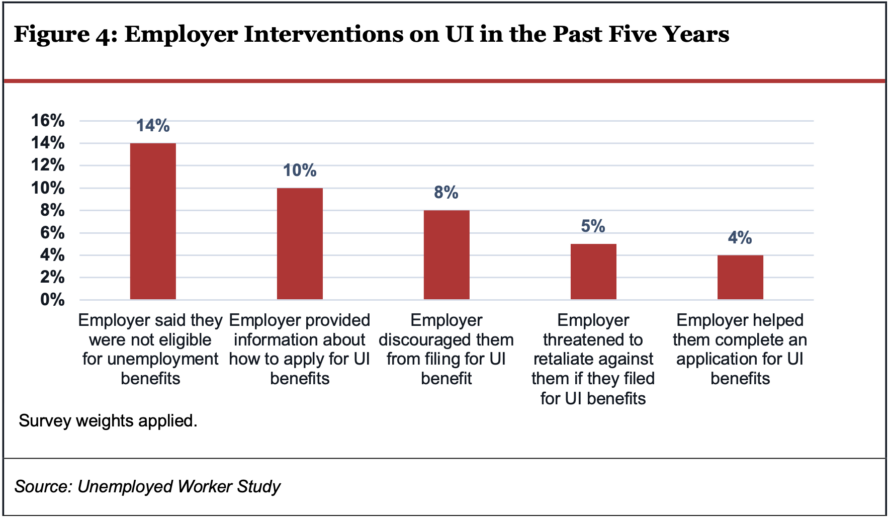
Highly Paid and Educated Workers Receive More Help from Employers to Apply for UI
Higher wage workers and workers with higher levels of formal education were significantly more likely to say that an employer helped or encouraged them to apply for UI benefits. (In contrast, employers hindered workers from applying for UI benefits at roughly the same rate regardless of education or pay.) Overall 16 percent of college educated workers reported that an employer took some action to help them apply for benefits compared to 12 percent of workers without a college degree.[37] Even more striking, 25 percent of the most highly paid workers (the highest quartile of pre-unemployment earnings) reported that an employer took action to help them apply for benefits compared to 13 percent of less highly compensated workers.[38]
Employer assistance in applying for UI benefits also varied by region of the country. Workers in East South Central states (Kentucky, Tennessee, Mississippi and Alabama) reported the lowest rates of assistance from employers, and workers in the mid-Atlantic states (New Jersey, New York, and Pennsylvania) reported the highest rates of assistance.
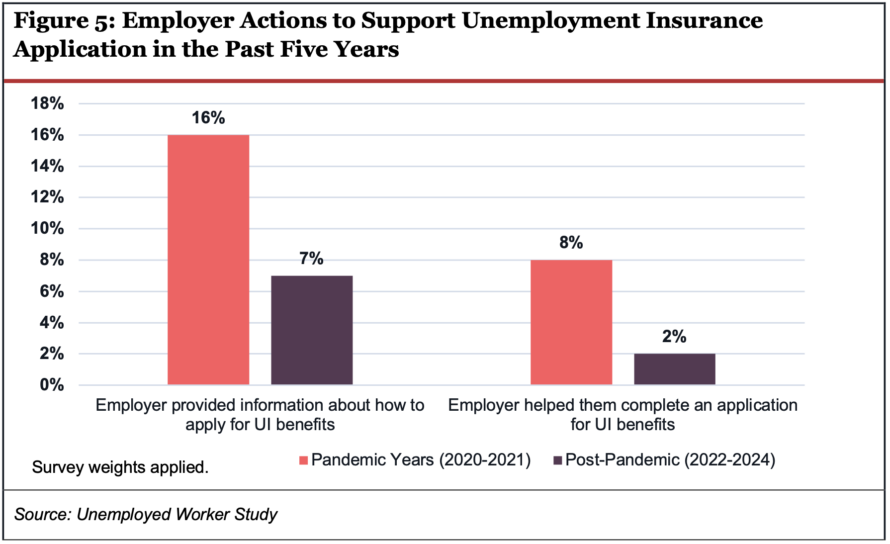
During the pandemic many states suspended or modified experience rating to ensure employers would not face higher taxes as a result of a disaster beyond their control.[39] While rates of employer deterrence in applying for UI benefits did not change during this period, employer assistance with UI was more common during the pandemic than in the aftermath. The Unemployed Worker Study finds that more than twice as many workers (16%) reported receiving UI information from an employer during the pandemic compared to workers who were unemployed after the pandemic (7%).[40] This includes 8 percent of workers who reported an employer helped them fill out an application during the pandemic compared to just 2 percent after the pandemic.[41]
For Many Workers, UI Benefits Are Not Enough
Nearly 1 in 5 (19%) of UI applicants nationwide reported that the benefits they received were not adequate to meet their financial needs. However, this percentage differed significantly by state, since states vary dramatically in the amount of support they provide to unemployed workers. For example, in the first quarter of 2024, workers in Alabama received an average benefit of $252 per week, replacing just 29 percent of their prior wages on average, compared to workers in Washington state, who received an average benefit of $721 a week, replacing 49 percent of their prior wages on average.[42]
The Unemployed Worker Study finds that workers in states that provide lower average UI benefits (as a percentage of average wages) were more likely to report that they did not receive enough in benefits. As noted above, 33 percent of workers who received UI benefits still reported food insecurity during their period of unemployment. In the quarter of states with the lowest replacement rates (measured as average weekly benefits as a percentage of average weekly wages), 25 percent of UI applicants said that benefits were inadequate in terms of amount, compared to just 11 percent in the states with the highest replacement rates.[43]
Finding a new job can be a lengthy process—yet unemployment benefits are time-limited and do not always last long enough for workers to secure new employment. The Unemployed Worker Study finds that 13 percent of UI applicants nationwide reported their benefits were inadequate in terms of duration. Here too, there was significant variation among states: While 26 weeks used to be the nationwide standard for UI duration during non-recession periods, a number of states have cut the maximum duration of benefits to as little as 12 weeks.[44] We find that UI applicants in states with shorter maximum durations of UI benefits were more likely than those in states that provided 26 weeks to report that the length of time they were able to receive UI was not adequate.
Federal pandemic UI programs provided longer durations of benefits nationwide: The Unemployed Worker Study finds that during the pandemic, 10 percent of workers reported that their UI benefits did not last long enough. After the pandemic, this rose to 15 percent.[45]

| Lowest (least generous) quartile | 25% |
|---|---|
| Second | 25% |
| Third | 13% |
| Highest (most generous) quartile | 11% |
Source: Unemployed Worker Study
Southern States Offer Weaker Support for Unemployed Workers
States have wide latitude in setting the parameters of how UI is administered, determining eligibility, benefit levels and duration, and how to allocate funds for administration. As a result, workers’ experiences with UI vary state by state, and also by region of the country. Researchers have noted that Southern states tend to provide among the lowest benefits, shortest potential benefit durations, and most exclusionary eligibility criteria, and have lower take-up rates for UI benefits.[46]
Our survey findings corroborate these patterns. UI applicants from states in the South were 28 percent more likely to report any type of difficulty applying for UI benefits than applicants from non-Southern states.[47] The Unemployed Worker Study finds that workers who applied for UI benefits in the South were significantly more likely than their counterparts elsewhere in the country to report experiencing:
- Discrimination in the UI application process (reported by 13 percent of applicants from the South compared to 2 percent of applicants from other regions of the country)[48]—indeed, virtually all of the applicants who reported discrimination in the process of UI application in the survey sample lived in the South;
- Delays in payments (reported by 24 percent of applicants from the South compared to 15 percent of applicants from other regions of the country);
- Underpayments, where the UI agency pays out a lower level of benefits than workers are legally entitled to (reported by 15 of applicants from the South compared to 9 percent for applicants from other regions of the country);
- Inadequate benefit duration (reported by 22 percent for applicants from the South compared to 18 percent of applicants from other regions of the country).
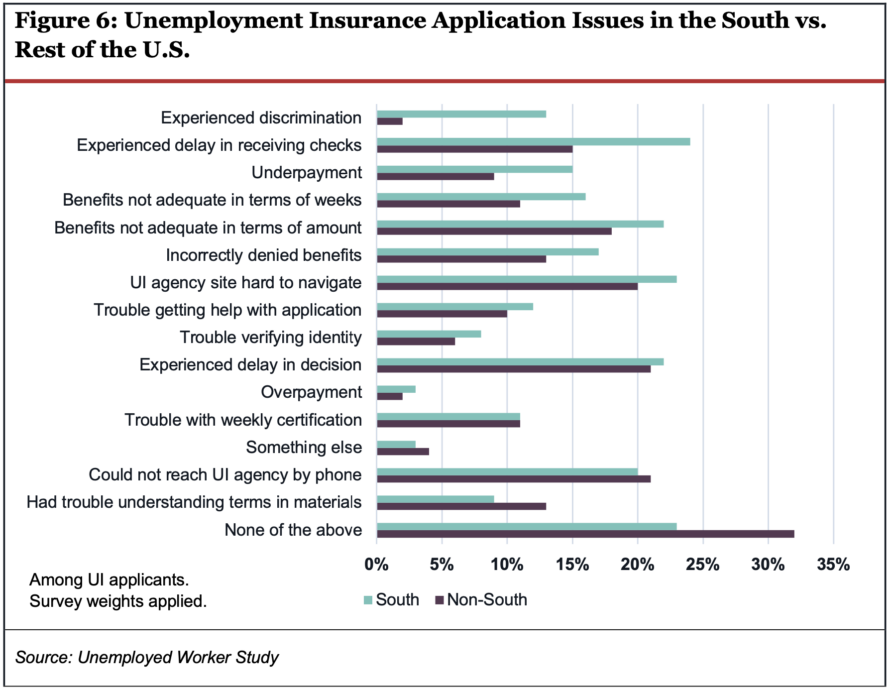
What is the source of this regional trend? Chandra Childers at the Economic Policy Institute notes that Black workers are more likely to live and work in southern states and situates the deficient UI system as part of a failed Southern economic model “rooted in racism.”[49] Heather McGhee adds that the deficient UI system in the South is emblematic of “drained pool politics”—just as towns drained their public pools after the Jim Crow era rather than integrate them, denying everyone the chance to swim, racism has been mobilized to underfund public goods like UI that benefit workers of all backgrounds.[50] While this mindset may be particularly potent in the South, McGhee notes that it permeates the entire country and may account more broadly for the nation’s lack of adequate support for social infrastructure like the UI system.
Conclusion and Policy Recommendations
The Unemployed Workers Study confirms that UI benefits significantly reduce hardship for unemployed workers, even as workers face significant barriers to accessing benefits, including difficulty navigating UI websites, problems reaching UI agencies by phone, and delayed payments. Employers play a key role in workers’ access to UI, in some cases helping employees apply and, more often, taking actions to discourage workers from claiming benefits.
As crucial as UI benefits were, many workers reported that benefit amounts and duration were still not adequate to support them as they sought new work, including many who reported experiencing food and housing insecurity despite receiving UI benefits. Workers in states that had cut the maximum length of time workers could receive benefits to less than 26 weeks were particularly likely to point to the inadequacy of benefit duration. UI applicants from states in the South were significantly more likely to report difficulty applying for UI benefits as well as delays in payments and discrimination in accessing benefits.
Together, our findings demonstrate that UI is vitally important to workers but that the program falls short in critical ways. This survey highlights the urgent need for UI reform at both the federal and state levels. We detail policy recommendations below and also offer advice for employers that want to support departing employees through the unemployment process.
Recommendations for State Policymakers
Under the joint state-federal UI system, states have significant control over UI benefit levels, duration, eligibility, and workers’ ability to access benefits. Based on the findings from the survey, state policymakers should use their authority to:
- Improve UI access. The survey finds that workers continue to experience substantial challenges in accessing UI benefits even after the pandemic. States should improve the customer experience on UI agency websites and guarantee that there are sufficient trained merit staff to handle phone inquiries more effectively and process claims and payments in a timely manner. The U.S. Department of Labor’s Customer Experience Checklist for state agencies and program guidance on equitable access offer valuable guides for improvement.[51] Policymakers should pay particular attention to ensuring that ID verification procedures do not block eligible workers from applying for or accessing benefits.
- Ensure that UI benefit levels are adequate to meet the needs of unemployed workers. State lawmakers should reform UI benefit formulas to replace a higher proportion of wages, determining benefit amounts using a progressive formula that replaces a higher proportion of pay for the lowest earners and gradually decreases for the highest earners, up to a cap. Policymakers should index minimum and maximum benefit amounts to an adequate percentage of the state’s average wage.
- Ensure that UI duration is adequate to meet the needs of unemployed workers. State lawmakers should set the maximum duration of UI benefits to at least 30 weeks and guarantee a uniform maximum duration of benefits for all workers at all times.
- Broaden UI eligibility so that more unemployed workers qualify for support. Survey findings highlight a growing sense that workers are being unfairly denied UI benefits. To ensure more unemployed workers are eligible for UI support, policymakers should extend the base period for determining eligibility and replace complex monetary eligibility requirements with a simple formula making workers eligible if they work a minimum number of hours in their base period. State lawmakers should ensure that workers misclassified by their employers as independent contractors are recognized as employees eligible for UI benefits. Part-time workers and workers seeking part-time jobs should be eligible for UI. States should minimize burdensome and unnecessary UI work search requirements and provide benefits to workers compelled to quit their jobs for good cause. Policymakers should also consider establishing excluded workers programs to provide support to undocumented workers and others who are excluded from the federal UI system.[52]
- Reform UI financing to raise additional revenue and eliminate perverse incentives for employers. To ensure adequate funding to strengthen state UI systems along the lines described above, states should broaden their taxable wage base and index taxes to wages to automatically keep pace with wage growth. Survey findings on employers’ significant role in deterring workers from applying for benefits suggest that states should also rethink the experience rating systems that create this incentive. Instead, states could base employer taxes on changes in employee hours regardless of whether or not workers claim benefits. States should also penalize employers that try to dodge UI taxes by misclassifying workers.
- Launch a navigator program to provide additional support and information to unemployed workers. Survey findings suggest that many workers do not have a source of support or information for dealing with unemployment, and that workers with less formal education were significantly less likely to have any type of assistance. Policymakers should initiate a peer workforce navigator program, like the one piloted in Maine through U.S. Department of Labor and state funding, to help unemployed workers understand their options.[53]
The National Employment Law Project’s UI Policy Hub is a resource for state UI policy proposals and contains additional detail on the recommendations above.
Recommendations for Federal Policymakers
The survey underscores the numerous ways that workers’ experience of unemployment and the degree of support they receive varies based on the state where they are employed. To ensure all unemployed workers receive adequate support while seeking new work, Congress should set universal minimum standards that all states must meet and provide funding to meet these standards. Based on findings from the survey, federal policymakers should:
- Enact the UI Modernization and Recession Readiness Act.[54] This legislation, introduced in the previous Congress by Senators Wyden and Bennet and Representative Beyer, and due to be reintroduced in 2025, would establish a uniform set of standards for UI benefit levels, duration, and eligibility to make sure UI is adequate for all workers across states. The bill would also update emergency benefit programs so that the chaotic scramble workers experienced during the pandemic will not be repeated during future economic crises.
- Establish performance standards for equitable UI access. To improve workers’ access to UI benefits, policymakers should add access measures, including target UI recipiency rates, to the U.S. Department of Labor’s UI core measures and acceptable levels of performance. See the National Employment Law Project’s proposed performance standards for equitable access to UI for additional detail on this recommendation.[55]
- Improve funding for state and federal UI administration. State UI administration is funded by a federal tax on employers and allocated to state UI agencies through a grant formula. Policymakers should increase administrative funding to provide states with the resources to modernize systems and improve UI access. In addition, the U.S. Department of Labor Employment and Training Administration plays a critical role in supporting state UI programs. Policymakers should act to strengthen funding and staff for the agency.
- Support innovative programs that reduce barriers to UI access. Policymakers should champion programs that address the continuing obstacles to UI access. For example, peer workforce navigator programs offer a promising means to improve access to unemployment benefits and new jobs,[56] while federal ID verification offerings, including Login.gov and the use of U.S. post office locations for in-person ID verification, can help prevent ID verification from becoming an impediment for legitimate claimants.[57]
Recommendations for Employers
Employers benefit from a well-functioning UI system, which can help them match with workers who have the right skills[58] and supports consumer demand during economic downturns. Our survey finds that employers play an important role in the successful functioning of the system. To keep UI strong and support their separating employees in navigating the system employers should:
- Provide information on how to apply for UI benefits to all separating employees and assist separating workers with their UI applications. Our survey finds that workers with more formal education and higher pay are more likely to receive employer help with their UI applications. Employers should value all of their employees enough to provide information and assistance with UI claims. Employers should not discourage workers from filing claims for UI benefits: The state UI agency will determine if workers are eligible or not.
- Respond promptly and accurately to UI agency requests. Workers’ UI claims can be delayed or wrongfully denied if employers do not reply in a timely manner to requests for separation, employment, and wage data, or requests to review determinations or attend hearings.
- Do not indiscriminately contest workers’ claims to UI benefits. Some employers reportedly aim to reduce their UI tax rates by routinely contesting every former employee’s application for UI benefits, even if the claim is legitimate.[59] Employers should not prevent the workers they have laid off from accessing support to which they are entitled.
- Ensure that employees are properly classified. When workers are classified as “independent contractors” they are generally not eligible for UI benefits and also lose many other employment rights and protections.[60] Responsible employers correctly classify the workers that power their business as employees.
- Participate in work sharing (also known as short-time compensation) to avoid layoffs. Many states operate work sharing programs that enable employers to reduce hours of work for employees rather than conducting layoffs.[61] Workers who experience reduced hours can collect a percentage of UI benefits to replace some of their lost wages, while employers are able to retain their trained workforces until economic demand increases again.
Methodology
The Unemployed Workers Study was fielded in partnership with the online polling firm YouGov. The survey received institutional review board approval from Columbia University. YouGov recruited 1,480 respondents from its online panel matching the demographic characteristics of individuals who had been unemployed at some point between 2019 and 2024 using data from the monthly Current Population Survey pooled from January 2019 through July 2024 (Flood et al. 2024). In this matching, YouGov used the joint distributions of education (four categories: HS or less, some college; BA; or post-BA), race (five categories: white, Black, Hispanic, Asian-American, or other), age (five categories: 18-29, 30-44, 45-54, 55-64, or 65+), and gender (two categories: those who identify as male and those who do not). YouGov then developed survey weights based on gender, age, race/ethnicity, education, and U.S. Census region based on voter registration lists, the U.S. Census American Community Survey, and the U.S. Census Current Population Survey, as well as 2020 Presidential vote. The weights range from 0.27 to 2.95 with a mean of 1 and a standard deviation of 0.36. We apply these survey weights in all results that follow. The survey asked about a range of experiences for unemployed workers, who were describing their most recent spell of unemployment. These experiences included whether respondents had applied for UI benefits; if they applied, whether their claim was contested and whether they received benefits; the qualitative experience of applying for benefits; and any financial hardships they experienced during the spell of unemployment. Respondents also provided a range of demographic characteristics, as well as characteristics of their previous job.
Endnotes
[1] Rohan Kekre, “Unemployment Insurance in Macroeconomic Stabilization,” The Review of Economic Studies 90, Issue 5 (2023): 2439–2480, https://doi.org/10.1093/restud/rdac080.
[2] Ammar Farooq, Adriana D. Kugler, and Umberto Muratori, “Do Unemployment Insurance Benefits Improve Match Quality? Evidence From Recent US Recessions,” National Bureau of Economic Research (2020), https://www.nber.org/system/files/working_papers/w27574/revisions/w27574.rev0.pdf.
[3] Nick Gwyn, State Cuts Continue to Unravel Basic Support for Unemployed Workers (Washington, DC: Center on Budget and Policy Priorities, June 27, 2022), https://www.cbpp.org/research/state-budget-and-tax/state-cuts-continue-to-unravel-basic-support-for-unemployed-workers; Adriana D. Kugler, Umberto Muratori, and Ammar Farooq, The Impacts of Unemployment Benefits on Job Match Quality and Labour Market Functioning (London: Centre for Economic Policy Research, February 7, 2021), https://cepr.org/voxeu/columns/impacts-unemployment-benefits-job-match-quality-and-labour-market-functioning.
[4] Gordon B. Dahl and Matthew M. Knepper, “Why Is Workplace Sexual Harassment Underreported? The Value
Of Outside Options Amid the Threat of Retaliation,” National Bureau of Economic Research (2021), http://www.nber.org/papers/w29248; Jonas Heese, Gerardo Pérez-Cavazos, “The Effect of Retaliation Costs on Employee Whistleblowing,” Journal of Accounting and Economics 71, Issues 2–3, (April–May 2021): 101385, https://doi.org/10.1016/j.jacceco.2020.101385.
[5] Patrick Carey, et. al., “Applying for and Receiving Unemployment Insurance Benefits During the Coronavirus Pandemic,” Monthly Labor Review, U.S. Bureau of Labor Statistics, (September 2021), https://doi.org/10.21916/mlr.2021.19; Frances Chen and Em Shrider, Expanded Unemployment Insurance Benefits During Pandemic Lowered Poverty Rates Across All Racial Groups, U.S. Census Bureau, (September 14, 2021), https://www.census.gov/library/stories/2021/09/did-unemployment-insurance-lower-official-poverty-rates-in-2020.html; Christopher Carroll, et. al., “Welfare and Spending Effects of Consumption Stimulus Policies,” Finance and Economics Discussion Series (Washington: Board of Governors of the Federal Reserve System, 2023),
https://doi.org/10.17016/FEDS.2023.002.
[6] Unemployment Insurance: Transformation Needed to Address Program Design, Infrastructure, and Integrity Risks, (Washington, D.C.: Government Accountability Office, 2022) https://www.gao.gov/products/gao-22-105162
[7] Josh Bivens, et. al., Reforming Unemployment Insurance: Stabilizing a System in Crisis and Laying the Foundation for Equity (New York and Washington, D.C.: Center for American Progress, The Center for Popular Democracy, Economic Policy Institute, Groundwork Collaborative, National Employment Law Project, The Washington Center for Equitable Growth, 2021), https://www.nelp.org/insights-research/reforming-unemployment-insurance-stabilizing-a-system-in-crisis-and-laying-the-foundation-for-equity/.
[8] Amy Traub and Kim Diehl, Reforming Unemployment Insurance is a Racial Justice Imperative, (New York: National Employment Law Project, 2022), https://www.nelp.org/publication/reforming-unemployment-insurance-is-a-racial-justice-imperative/.
[9] Daphné Skandalis, Ioana Elena Marinescu, and Maxim Massenkoff, “Racial Inequality in the U.S. Unemployment Insurance System,” National Bureau of Economic Research (2023) https://www.nber.org/papers/w30252.
[10] Chen and Shrider, Expanded Unemployment Insurance Benefits During Pandemic Lowered Poverty Rates Across All Racial Groups.
[11] Carroll, et. al., “Welfare and Spending Effects of Consumption Stimulus Policies.”
[12] Insights and Successes: ARPA Investments in Unemployment Insurance Modernization (Washington, D.C., U.S. Department of Labor, 2023), https://www.dol.gov/sites/dolgov/files/ETA/ui-modernization/ARPA%20Investments%20in%20Unemployment%20Insurance%20Modernization.pdf.
[13] After controlling for education, gender, race and ethnicity, age, past union membership, quartiles of pre-unemployment weekly earnings, pre-unemployment type of employer, pre-unemployment work arrangements, state of unemployment, and year of unemployment, this is a 22 percentage point difference statistically significant at p<0.001.
[14] Difference statistically significant at p<0.05.
[15] The difference was not statistically significant at conventional levels of significance (p=0.11).
[16] Full controls include education, gender, race and ethnicity, age, past union membership, quartiles of pre-unemployment weekly earnings, pre-unemployment type of employer, pre-unemployment work arrangements, state of unemployment, and year of unemployment
[17] Carey, et. al., “Applying for and Receiving Unemployment Insurance Benefits During the Coronavirus Pandemic.”
[18] Cat Zakrzewski and Tonya Riley, “The Technology 202: State Unemployment Websites Are Crashing Amid Record Number of Claims,” Washington Post, April 2, 2020,
https://www.washingtonpost.com/news/powerpost/paloma/the-technology-202/2020/04/02/the-technology-202-state-unemployment-websites-are-crashing-amid-record-number-of-claims/5e84ee3e88e0fa101a758301/; Patrick McGeehan, “‘I Cry Night and Day’: How It Took One Woman 8 Weeks to Get Unemployment,” New York Times, May 8, 2020, https://www.nytimes.com/2020/05/08/nyregion/unemployment-benefits-ny-coronavirus.html.
[19] Rebecca Dixon, Examining the Administration of the Unemployment Insurance System (New York: National Employment Law Project, 2022), https://www.nelp.org/app/uploads/2022/09/UI-Oversight-Hearing-Testimony-9-21-2022.pdf.
[20] See for example: Christina Giardinelli, “Oregon Man Becomes Homeless While Waiting for Unemployment Benefits,” KATU, April 16th 2024, https://kval.com/news/local/oregon-man-becomes-homeless-while-waiting-for-unemployment-benefits; Valerie Chinn, “Thousands of Kentuckians Remain Frustrated, Stuck for Months in State’s Clogged Unemployment System,” WDRB, July 26, 2024, https://www.wdrb.com/news/thousands-of-kentuckians-remain-frustrated-stuck-for-months-in-states-clogged-unemployment-system/article_94b60cc4-4922-11ef-b9c2-9facc8fb897e.html.
[21] Michele Evermore, States Still Challenged in Making Timely Unemployment Payments to Laid Off Workers, (New York: The Century Foundation, March 2024), https://tcf.org/content/commentary/states-still-challenged-in-making-timely-unemployment-payments-to-laid-off-workers/.
[22] Unemployment Insurance Performance Management, U.S. Department of Labor,
https://oui.doleta.gov/unemploy/bqc.asp.
[23] Authors’ analysis of data from U.S. Department of Labor forms ETA 207 and ETA 218. For an illustration of this, see https://tcf-ui-data.shinyapps.io/ui-data-explorer/.
[24] For example, self-employed workers, workers seeking part-time work, and workers who do not have a long work history were eligible for UI benefits under pandemic programs but not under the eligibility rules of many states. The requirement that workers document their search for new employment in order to continue receiving benefits was also suspended during the pandemic.
[25] Authors’ communication with UI advocate Flannery O’Rourke.
[26] Characteristics of Unemployment Insurance Applicants and Benefit Recipients: 2018, (Washington: D.C.: U.S. Bureau of Labor Statistics, 2019), https://www.bls.gov/news.release/archives/uisup_09252019.htm.
[27] Michele Evermore, Alexander Hertel-Fernandez, and David Madland, Community Navigators Can Increase Access to Unemployment Benefits and New Jobs While Building Worker Power (Washington, D.C.: The Center for American Progress, Oct 22, 2024), https://www.americanprogress.org/article/community-navigators-can-increase-access-to-unemployment-benefits-and-new-jobs-while-building-worker-power/.
[28] “Unemployment Insurance Integrity Strategic Plan Fiscal Year 2023,” U.S. Department of Labor, https://oui.doleta.gov/unemploy/pdf/ui_prog_integrity_2023.pdf.
[29] Difference statistically significant at p<0.05.
[30] Alex Najibi, “Racial Discrimination in Face Recognition Technology,” Science in the News (blog), Harvard Graduate School of the Arts and Sciences, October 24, 2020, https://sitn.hms.harvard.edu/flash/2020/racial-discrimination-in-face-recognition-technology/.
[31] Kenneth P. Brevoort, Philipp Grimm, and Michelle Kambara, CFPB Data Point: Credit Invisibles, (Washington, DC: Consumer Financial Protection Bureau Office of Research, 2025), https://files.consumerfinance.gov/f/201505_cfpb_data-point-credit-invisibles.pdf.
[32] Brent Parton, “Unemployment Insurance Program Letter No. 11-23,” U.S. Department of Labor, July 13, 2023, https://www.dol.gov/sites/dolgov/files/ETA/advisories/UIPL/2023/UIPL%2011-23/UIPL%2011-23.pdf.
[33] Alix Gould-Werth, “Workplace Experiences and Unemployment Insurance Claims: How Personal Relationships and the Structure of Work Shape Access to Public Benefits,” Social Service Review 90, No. 2 (June 2016) https://doi.org/10.1086/687298; Marta Lachowska, Isaac Sorkin, and Stephen A. Woodbury, “Firms and Unemployment Insurance Take-Up,” National Bureau of Economic Research (2023), http://www.nber.org/papers/w30266; Patricia M Anderson, and Bruce D Meyer, “The Effects of the Unemployment Insurance Payroll Tax on Wages, Employment, Claims and Denials,” Journal of Public Economics 78, Issues 1–2, (October 2000): 81-106, https://doi.org/10.1016/S0047-2727(99)00112-7.
[34] Experience rating based on UI claims is used in every state except Alaska: In Alaska, employers pay higher taxes when they reduce their payroll, regardless of whether their employees successfully claim UI benefits.
[35] Gould-Werth, “Workplace Experiences and Unemployment Insurance Claims;” Lachowska, Sorkin, and Woodbury, “Firms and Unemployment Insurance Take-Up;” Anderson and Meyer, ““The Effects of the Unemployment Insurance Payroll Tax.”
[36] Bivens, et. al., Reforming Unemployment Insurance.
[37] Difference statistically significant at p<0.05.
[38] Difference statistically significant at p<0.001.
[39] Mark Duggan, Audrey Guo, and Andrew C. Johnston, Unemployment During the Pandemic: How to Avoid Going for Broke, (Stanford, CA: Stanford Institute for Economic Policy Research, 2020), https://siepr.stanford.edu/publications/policy-brief/unemployment-during-pandemic-how-avoid-going-broke.
[40] Difference statistically significant at p<0.001.
[41] Difference statistically significant at p<0.001.
[42] “UI Replacement Rates Report,” U.S. Department of Labor, https://oui.doleta.gov/unemploy/repl_ratio/repl_ratio_rpt.asp.
[43] Difference statistically significant at p<0.05.
[44] “Significant Provisions of State Unemployment Insurance Laws Effective July 2024,” U.S. Department of Labor, https://oui.doleta.gov/unemploy/content/sigpros/2020-2029/July2024.pdf.
[45] Difference statistically significant at p=0.11.
[46] Traub and Diehl, Reforming Unemployment Insurance is a Racial Justice Imperative; Chandra Childers, Rooted in Racism and Economic Exploitation: The Failed Southern Economic Development Model, (Washington, D.C.: Economic Policy Institute, October 11, 2023) https://www.epi.org/publication/rooted-in-racism/; Elira Kuka and Bryan Stuart, Racial Inequality in Unemployment Insurance Receipt and Take-Up, (Philadelphia: Federal Reserve Bank of Philadelphia, March 2022) https://doi.org/10.21799/frbp.wp.2022.09.
[47] Southern states are defined by the U.S. Census Bureau to include Alabama, Arkansas, Delaware, Florida, Georgia, Kentucky, Louisiana, Maryland, Mississippi, North Carolina, Oklahoma, South Carolina, Tennessee, Texas, Virginia, Washington DC, and West Virginia. Difference statistically significant at p<0.05.
[48] Difference statistically significant at p<0.001.
[49] Childers, Rooted in Racism.
[50] Heather McGhee and Ezra Klein, “What Drained Pool Politics Cost America,” New York Times, February 16, 2021, https://www.nytimes.com/2021/02/16/opinion/ezra-klein-podcast-heather-mcghee.html; Heather McGhee, The Sum of Us: What Racism Costs Everyone and How We Can Prosper Together, (New York: Penguin Random House, 2021).
[51] José Javier Rodríguez, “Training and Employment Notice 18-24,” U.S. Department of Labor, December 31, 2024, https://www.dol.gov/sites/dolgov/files/ETA/advisories/TEN/2024/TEN%2018-24/TEN%2018-24.pdf; Brent Parton, “Unemployment Insurance Program Letter No. 01-24,” U.S. Department of Labor, November 8, 2023, https://www.dol.gov/agencies/eta/advisories/uipl-01-24.
[52] Excluded Worker Programs, (New York: National Employment Law Project, 2023) https://www.nelp.org/insights-research/excluded-worker-programs/.
[53] Evermore, Hertel-Fernandez, and Madland, Community Navigators Can Increase Access to Unemployment Benefits.
[54] U.S. Congress, Senate, Unemployment Insurance Modernization and Recession Readiness Act, S 3140, 118th Cong. Introduced in Senate October 26, 2023,https://www.congress.gov/bill/118th-congress/senate-bill/3140/text.
[55] Amy Traub, Proposed Performance Standards for Equitable Access to Unemployment Insurance, (New York: National Employment Law Project, 2023), https://www.nelp.org/app/uploads/2023/06/Proposed-Performance-Standards-for-Equitable-Access-to-Unemployment-Insurance-.pdf.
[56] Evermore, Hertel-Fernandez, and Madland, Community Navigators Can Increase Access to Unemployment Benefits.
[57] Brent Parton, “Unemployment Insurance Program Letter No. 11-23.”
[58] Farooq, Kugler, and Muratori, “Do Unemployment Insurance Benefits Improve Match Quality?”
[59] Jason DeParle, “Contesting Jobless Claims Becomes a Boom Industry,” New York Times, April 3, 2010, https://www.nytimes.com/2010/04/04/us/04talx.html.
[60] “End Independent Contractor Misclassification,” National Employment Law Project, 2024, https://www.nelp.org/explore-the-issues/contracted-workers/misclassified-workers/.
[61] “Short-Time Compensation,” Fact Sheet, U.S. Department of Labor, https://oui.doleta.gov/unemploy/docs/stc_fact_sheet.pdf.





